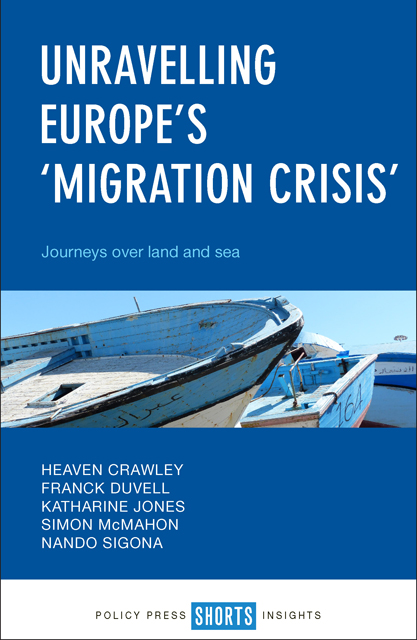Book contents
- Frontmatter
- Contents
- List of figures
- List of boxes
- Acronyms
- Notes on the authors
- Acknowledgements
- Foreword by Joanne Liu
- one The view from Europe
- two Unravelling Europe’s ‘migration crisis’
- three Not one route but many: unpacking migration to Europe
- four The decision to leave
- five Navigating borders and danger: the use of smugglers
- six Moving on
- seven Across the sea… and beyond
- eight Rethinking Europe’s response
- References
- Index
three - Not one route but many: unpacking migration to Europe
Published online by Cambridge University Press: 21 April 2023
- Frontmatter
- Contents
- List of figures
- List of boxes
- Acronyms
- Notes on the authors
- Acknowledgements
- Foreword by Joanne Liu
- one The view from Europe
- two Unravelling Europe’s ‘migration crisis’
- three Not one route but many: unpacking migration to Europe
- four The decision to leave
- five Navigating borders and danger: the use of smugglers
- six Moving on
- seven Across the sea… and beyond
- eight Rethinking Europe’s response
- References
- Index
Summary
Although migration across the Mediterranean in 2015 was often discussed as if it was a single flow it was, as we have seen, composed of two routes – one to Italy, one to Greece – which were themselves a product of the merging of multiple flows which converged in Libya and Turkey respectively. Each of these flows was, in turn, composed of people with different characteristics and different migratory experiences. This chapter outlines the characteristics of the refugees and migrants we spoke to during our research before describing the routes and journeys that they took prior to their arrival in Europe. These included not only the journey to Europe itself but also longer-term trajectories and serial migration decisions which involve what we refer to as ‘stops’ and ‘stays’ of varying duration, often with no predetermined final destination.
Who was on the move?
There were significant differences between the Eastern and Central Mediterranean routes not only in terms of the scale and history of migration flows but also in terms of the composition of people making the different sea crossings during 2015. While 90% of those arriving in Greece came from just three countries (Syria, Afghanistan and Iraq), arrivals in Italy were much more diverse: around a quarter of all arrivals were Eritrean (25.5%), followed by Nigerians (14.5%), Somalis (8.1%), Sudanese (5.8%), Gambians (5.8%) and Syrians (3.8%), with the remainder originating from 53 different countries (IOM, 2016a).
While we do not claim our data to be completely representative, the sample of people interviewed is one of the largest of its kind and broadly reflects the composition of those arriving in Greece and Italy in 2015. In Greece the largest proportion originated from Syria (44.5%), followed by Afghanistan (20.5%) and Iraq (13.5%) (see Figure 3.1). In Italy, our sample mirrors the marked diversity of countries of origin among sea arrivals (see Figure 3.2).
There were also differences in terms of age, gender and whether people were travelling with their children in each of the case study countries, some of which reflected broader trends. Just over two-thirds (65%) of those interviewed were aged 18–29 but the proportion was higher in Italy (76.5%) than in Greece (54.5%). This reflects the fact that those arriving in Greece were more likely to be older and travelling in family groups.
- Type
- Chapter
- Information
- Unravelling Europe's 'Migration Crisis'Journeys Over Land and Sea, pp. 29 - 50Publisher: Bristol University PressPrint publication year: 2017



